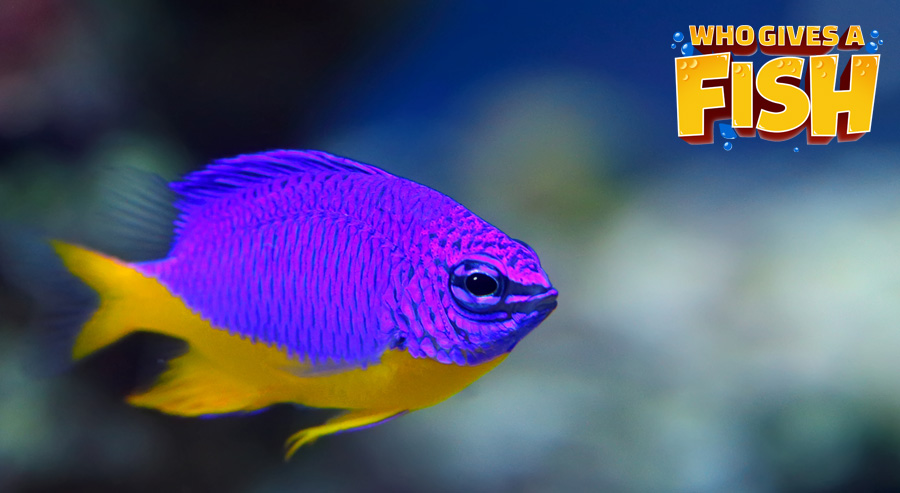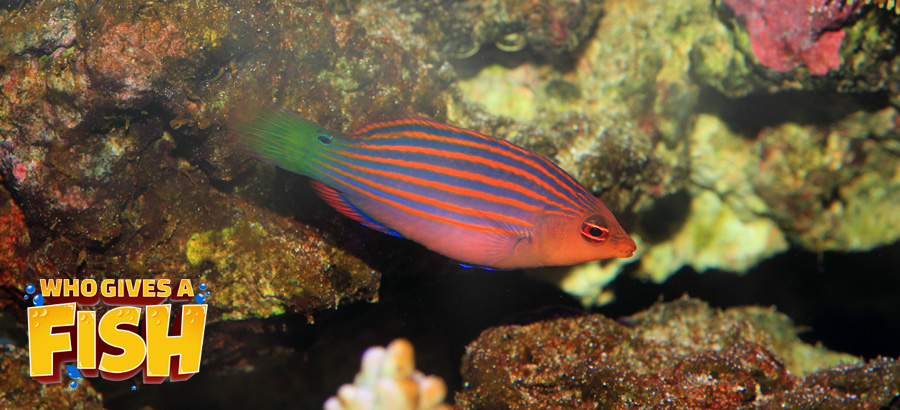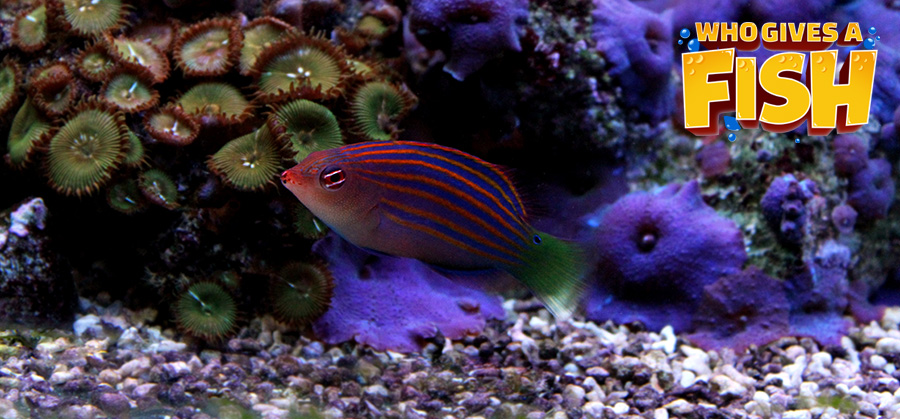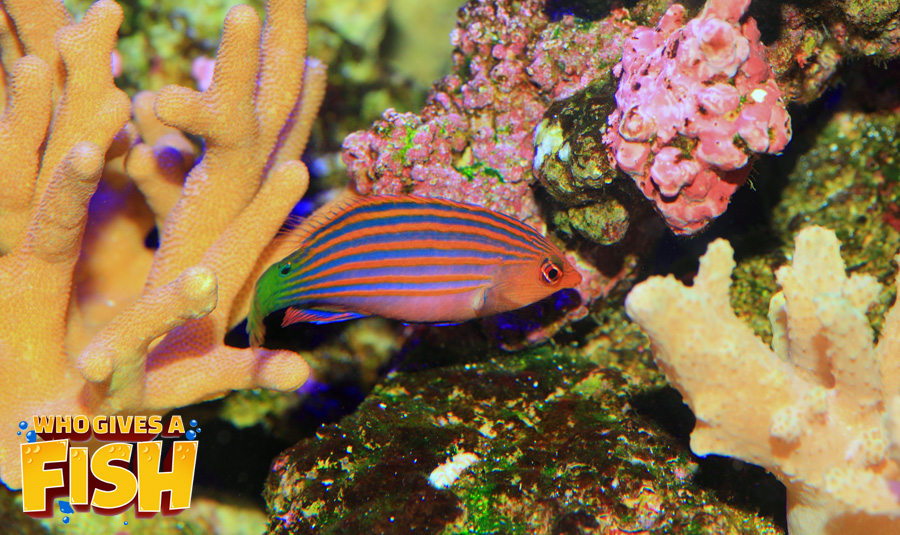Six Line Wrasse
The little Six Line Wrasse is a beautiful fish both visually and behaviorally. They are hardy, easy to keep and extremely popular in the home aquarium.
The Six Line Wrasse is very abundant through fish shops, almost everyone who has gone in looking for fish will have seen one at some point, often resulting in a spontaneous purchase due to their lovely appearance. They are well known for being hardy little fish, with a long-life span and a resistance to disease.
- Experience Level: Beginner/Moderate
- Hardiness: Hardy
- Minimum Tank Size: 30 gal (114 L)
- Size of fish: 3.9 inches (10 cm)
- Temperament: Semi Agressive
- Temperature: 74.0 to 79.0° F (23.3 to 26.1° C)
- pH Range: 8.1-8.4
- Diet: Carnivore
Table of Contents
Introduction
Aquarium Setup
Difficulty
Feeding
Breeding and Social
Once established in a tank, they are well known for being good pest controllers as they enjoy pyramidellid snails, flatworms and have a real taste for bristle worms. Furthermore, they have been known to enjoy cleaning parasitic copepods and isopods from the fins and bodies of other fish.
The Six Line Wrasse is known for being very good at hiding, so getting a good snap of your fish to share can be hard. They have a diurnal activity pattern, so are seen during the day and sleep at night. As with other Wrasses, they will form a mucous cocoon to sleep in each night. Some people worry that this mucous on a daily basis will affect their water, but there is no harm to your parameters from it. This cocoon provides protection from predators by hiding the smell of the wrasse.
In the wild, the Six Line Wrasse is quite a shy fish but once they are comfortable in the home aquarium their small personalities can really shine. This wrasse is definitely reef safe and will not bother any of your corals or anemones. Fish communities are fine but will overpower more passive species and are even known to push around larger fish. It is best being housed with larger fish and more aggressive fish that will keep it in line. The Six Line Wrasse should be the last addition to your tank if possible to allow the others to develop their territories. They are not usually well mixed with other lined wrasses in the home aquarium.
The Six Line Wrasse has a beautiful bluish-purple/pink body with 6 bright orange stripes. 2 of these lines continue right through its bright red eyes! A very distinguishable and unique feature of the Wrasse. A light orange color is found over the cheek area with some dots going from the gills and up under the eyes and to the mouth. The back fin is a yellow-green color, and in front of this is a small “false eye” that is black with a blue edge. This “false eye” is used to confuse potential predators, making it look as if the fish is looking at them. Their other fins are much lighter in color, generally being clear or a translucent yellow color.
Six Line Wrasse Aquarium Guide
- Minimum Tank Size: 30 gal (114 L)
- Suitable for Nano Tank: No
- Live Rock Requirement: Yes
- Substrate Type: Any
- Lighting Needs: Bright to Moderate
- Temperature: 74.0 to 79.0° F (23.3 to 26.1° C)
- Breeding Temperature: 79.0° F (26.1° C)
- Specific gravity: 1.020-1.025 SG
- pH Range: 8.1-8.4
- Brackish: No
- Water Movement: Any
- Water Region: All areas of the tank
Difficulty
Like all fish they are sensitive when first introduced to a new tank, but once this is done they become hardy and resistant. When purchasing, ensure that the fish is active and ask the seller to feed it to ensure it is eating well.
Feeding
The Six Line Wrasse is a carnivore and will feed on things like fish eggs, crab larvae, molluscs and crustaceans. Fish eggs are known to be a favorite of theirs. Provide a wide variety of foods for them, with an emphasis on small crustaceans if possible.
Due to being very active, they should be fed twice a day and will benefit a lot from a well-established tank with live rock. The live rock will allow them to pick on any micro fauna living in it. Parasitic isopods and copepods are also a part of their diet as they have been seen picking these off from other fish’s bodies and fins.
Six Line Wrasse Feeding Guide
- Diet: Carnivore
- Flake Food: Sometimes
- Pellet / Tablet: Sometimes – Soak pellets in water before introducing to the tank.
- Live Foods (fish, shrimp, worms): Isopods, Copepods etc
- Frozen Foods: Mysis, Brine Shrimp (gut loaded with vitamins and nutrients)
- Meaty Food: 100% of their diet
- Feeding Frequency: Several times per day. They will nibble on live rock and substrate.
Breeding
Generally, males are the larger of the two with females being the next biggest and juveniles being the smallest. Like many other fish, Males will show stronger coloring during mating. These have never been bred in captivity at the time of writing.
Social
Unfortunately, The Six Line Wrasse does not house well with other lined wrasses. They are for the most part reef safe and can be housed with semi-aggressive fish like Butterflies, Angels and Tangs. They will stay away from your corals and not bother any anemones either. They can also be housed in a fish only setting with Squirrelfish, Puffers and Goatfish.
You should avoid housing them with inverts like small shrimp or very small fish as these can become quick meals for the wrasse. Larger specimens like cleaner, marble and coral shrimp should be fine, however they have been known to attempt to take bites from these when hungry.
More passive, shy fish shouldn’t be added with the wrasse, examples of these are the Leopard Wrasse, Flasher Wrasse, Fairy Wrasses, Grammas, Gobies and Firefish. Sometimes Mandarins are OK buy they can also be picked on at times. Mandarins need live food from the rock, so will get beaten to important food sources by the wrasse as they are much slower feeders.
Slow feeders like Seahorses and Pipefish will die of starvation in the presence of a Six Line Wrasse, and on the flip side, the Six Line Wrasse will quickly become a meal for larger predators like Scorpion Fish, Lionfish and Groupers.





